115
Lesson 2: Air Pollution
Learning Objectives
- Define air pollution, identify its main sources, and explain its impact on health and the environment.
- Describe the importance of air quality monitoring and management and learn about the tools and techniques used in this process.
Introduction
Air pollution refers to the presence of harmful substances or pollutants in the Earth’s atmosphere, which can have detrimental effects on human health, the environment, and the overall quality of air. These pollutants can be in the form of gases, particles, or biological molecules that are released into the air through various human activities and natural processes.
Because of the relatively sparse population and dispersed industry, Saskatchewan has generally good air quality. However, common sources of air pollution in Saskatchewan include industrial emissions (pulp and paper, oil refining, mining), vehicle exhaust, power generation, agricultural activities, and natural occurrences such as forest fires. These activities release pollutants such as carbon monoxide, sulfur dioxide, nitrogen oxides, particulate matter, volatile organic compounds, and hazardous air pollutants.
The accumulation of these pollutants in the air can lead to a range of negative impacts. It can cause respiratory problems, such as asthma, bronchitis, and other chronic obstructive pulmonary diseases. Prolonged exposure to air pollution has also been linked to cardiovascular diseases, lung cancer, and other serious health conditions.
Moreover, air pollution can have adverse effects on the environment. It contributes to the formation of smog, acid rain, and ozone depletion. Pollutants can settle on land and bodies of water, leading to soil and water contamination, harming ecosystems, and affecting plant and animal life. Additionally, air pollution plays a significant role in climate change by contributing to the greenhouse effect and global warming.
To mitigate air pollution, efforts are made to reduce emissions through the use of cleaner technologies, promoting renewable energy sources, implementing stricter emission standards, adopting sustainable transportation practices, and raising public awareness about the importance of clean air and its impact on health and the environment.
Sources of Air Pollution
Air pollution typically consists of one or more of the following elements:
- Particulate Matter (PM): These are tiny particles suspended in the air, often referred to as soot, dust, or smoke. They can be directly emitted from industrial processes or formed indirectly through chemical reactions. PM can vary in size, and the smaller particles (PM2.5 and PM10) are of particular concern as they can penetrate deep into the respiratory system and cause respiratory problems, cardiovascular issues, and other health effects.
- Nitrogen Oxides (NOx): These are a group of gases, including nitrogen dioxide (NO2) and nitric oxide (NO), produced during high-temperature combustion processes. Industrial activities such as burning fossil fuels (coal, oil, natural gas) in power plants, boilers, and industrial furnaces are significant sources of NOx emissions. Nitrogen oxides contribute to the formation of smog and can have adverse respiratory effects on humans, as well as contribute to acid rain and the depletion of the ozone layer.
- Sulfur Oxides (SOx): These are gases, including sulfur dioxide (SO2), primarily produced by burning fossil fuels containing sulfur, such as coal and oil. Industrial facilities like power plants and industrial boilers are major sources of SOx emissions. Sulfur oxides contribute to the formation of acid rain and can have harmful effects on human health, particularly respiratory problems.
- Volatile Organic Compounds (VOCs): These are organic chemicals that can easily vaporize at room temperature. Industrial processes such as painting, surface coating, chemical manufacturing, and solvents usage release VOCs into the air. VOCs contribute to the formation of ground-level ozone (a major component of smog) and can have adverse health effects, including respiratory issues and the potential for long-term health problems.
- Hazardous Air Pollutants (HAPs): These are a group of toxic substances, including heavy metals (e.g., mercury, lead), asbestos, benzene, formaldehyde, and dioxins, which are emitted during industrial processes. These pollutants can cause a range of health effects, including cancer, neurological disorders, and respiratory problems.
Carbon Monoxide (CO): Vehicle exhaust also releases carbon monoxide, a colorless and odorless gas. High levels of CO can be toxic, reducing the blood’s ability to carry oxygen and causing symptoms such as headaches, dizziness, and fatigue. - Carbon Dioxide (CO2): While carbon dioxide is a natural component of the atmosphere, vehicle exhaust is a significant source of CO2 emissions, contributing to the greenhouse effect and climate change.
Industrial Emissions
Industries such as manufacturing, power generation, mining, and chemical production can release various pollutants that contribute to air pollution. These emissions can have detrimental effects on human health, the environment, and overall air quality.
Industrial emissions in Saskatchewan are generally sourced from pulp and paper, forestry products, oil refineries and mining. These pollutants can consist of a variety of components, including: particulate matter, nitrogen oxides, sulfur oxides, volatile compounds and hazardous air pollutants.
Vehicle Exhaust
Air pollution from vehicle exhaust refers to the release of harmful substances into the air as a result of burning fuel in vehicles. Vehicle exhaust emissions contribute significantly to air pollution, particularly in urban areas with high traffic congestion. Here are some key pollutants emitted from vehicle exhaust and their impacts on air quality and human health: particulate matter, nitrogen oxides, carbon monoxide, volatile organic compounds, and carbon dioxide
Power Generation
In Saskatchewan, electricity is generated primarily through coal and coke, and natural gas. These are non-renewable resources that release sulphur oxides, nitrogen oxides, particulate matter (soot) and mercury pollutants.
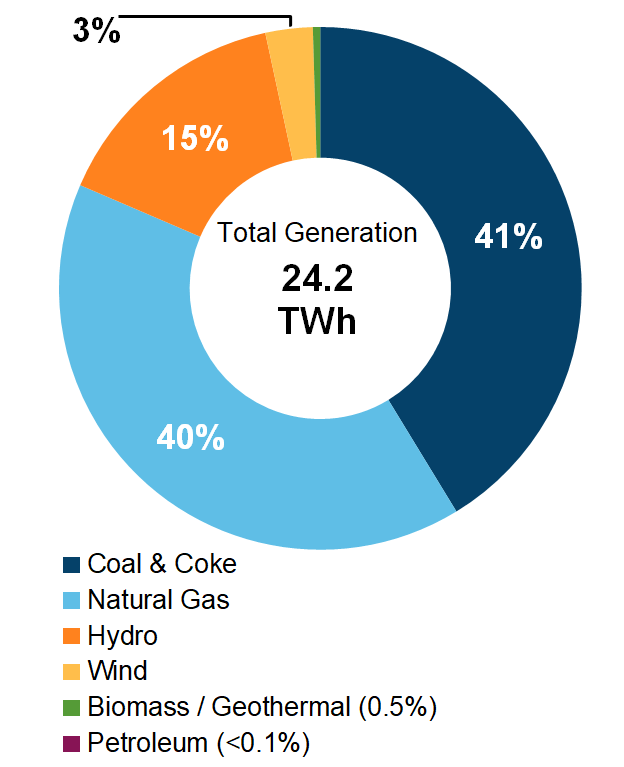
The impact from air pollutants from coal fired power plants include:
- smog
- asthma
- respiratory diseases
- premature deaths
- massive health care and economic costs due to lost worker productivity
According to the Canadian government:
“Southern Saskatchewan has some of the highest solar photovoltaic potential in Canada, with Regina and Saskatoon receiving an average 7.15 and 7.10 kilowatt-hours per square metre (kWh/m2), respectively. SaskPower and Saturn Power’s 10 MW Highfield Solar Project located near Swift Current is the province’s first utility scale solar generation project. The project began operating in October 2021 and can generate enough renewable power for about 2 500 homes
Southern Saskatchewan also has some of the highest wind energy potential in Canada. In 2020, the province had six wind farms in operation with an aggregated net capacity of 241 MW.
There is an opportunity for Indigenous communities to be leaders in sustainable energy production producing fewer air pollutants.
“SaskPower has entered into power purchase agreements with the First Nations Power Authority for two 10 MW projects expected to be in service in 2022: the Pesâkâstêw Solar Energy Facility, which is a partnership between George Gordon First Nation, Star Blanket Cree Nation and Natural Forces; and the Awasis Solar Energy Facility, which is a partnership between Cowessess First Nation and Elemental Energy.”[1]
Another noteworthy project is the Meadow Lake Tribal Council (MLTC) Bioenergy Centre which produces energy by burning waste products from nearby sawmills. This project is a partnership between the federal and provincial governments, and the MLTC. The project claims to:
- Generate carbon-neutral green power using sawmill biomass residuals.
- Decrease greenhouse gas emissions by more than 1 million tonnes over 25 years, and reduce smoke and other harmful matter to significantly improve air quality for residents.
Agricultural Activities
Farming can contribute to air pollution, posing environmental and health challenges.
Sources of Air Pollution from Farming:
- Agricultural Burning: In Saskatchewan, farmers often resort to agricultural burning to remove crop residues after harvest. This practice releases significant amounts of smoke, particulate matter, and pollutants such as carbon monoxide, volatile organic compounds (VOCs), and nitrogen oxides (NOx) into the atmosphere.
- Livestock Emissions: Animal agriculture, including cattle and poultry farming, contributes to air pollution through the release of ammonia (NH3), methane (CH4), and hydrogen sulfide (H2S). These gases, often emitted from manure management systems, can contribute to smog formation and have adverse effects on air quality.
- Fertilizer Application: The use of fertilizers in farming is essential for crop productivity, but improper application and excessive use can result in the release of ammonia and nitrogen compounds into the air. Ammonia emissions can contribute to the formation of particulate matter and impact air quality, while nitrogen compounds can lead to nitrogen oxide emissions, which contribute to smog formation.
Impacts of Air Pollution from Farming:
- Human Health: The pollutants emitted from agricultural burning and livestock operations can have detrimental effects on human health. Fine particulate matter (PM2.5) and gases such as ammonia and hydrogen sulfide can irritate the respiratory system, trigger or worsen respiratory conditions, and contribute to cardiovascular problems.
- Environmental Impact: Air pollution from farming can have far-reaching environmental consequences. Particulate matter and nitrogen compounds can contribute to eutrophication when deposited on land or water bodies, disrupting aquatic ecosystems. (Eutrophication is the process where plant nutrients accumulate on the land or water. This may seem like a good thing, but it promotes the excessive growth of unwanted or dangerous plants, for example algae making water sources unusable.) Additionally, pollutants can contribute to the formation of smog, reducing visibility and harming plant and animal life.
- Climate Change: Agricultural activities, including livestock emissions, contribute to greenhouse gas emissions, exacerbating climate change. Methane emissions from livestock, for example, have a significantly higher global warming potential than carbon dioxide.
Solutions to Mitigate Air Pollution:
- Alternative Residue Management: Encouraging farmers to adopt alternative practices to agricultural burning, such as conservation tillage, mulching, or incorporating crop residues into the soil, can help reduce the need for burning and subsequent air pollution.
- Improved Livestock Management: Implementing advanced manure management techniques, such as anaerobic digestion or composting, can help capture methane and reduce emissions from livestock operations. Proper ventilation and odor control measures in barns can also minimize the release of harmful gases.
- Precision Agriculture: Utilizing precision agriculture techniques can help optimize fertilizer application, reducing the potential for ammonia and nitrogen compound emissions. This involves using technologies like GPS and sensors to precisely apply fertilizers based on crop requirements, minimizing waste and environmental impacts.
- Education and Awareness: Promoting educational campaigns and awareness among farmers about the environmental and health impacts of air pollution can encourage the adoption of sustainable farming practices. Providing resources, training, and incentives for farmers to implement pollution-reducing techniques can facilitate positive change.
Addressing air pollution from farming in Saskatchewan is beneficial for safeguarding human health, preserving the environment, and mitigating climate change. By implementing alternative residue management, improving livestock practices, adopting precision agriculture, and raising awareness, farmers can reduce air pollution and contribute to a more sustainable agricultural sector.
Natural Occurances
Wildfires cause a large part of natural air pollution in Saskatchewan. The risk of wildfires can be mitigated by adopting certain control measures in your community.
Mitigation
The risk and damage of wildfires can be mitigated by adopting certain control measures in your community. Saskatchewan’s Emergency Planning Act requires communities to develop plans to response to the threat of wildfire.
The act can be accessed here:
https://publications.saskatchewan.ca/#/products/504
The Act dictates duties of local and provincial authorities, establishing the provincial and local committees, declaring an emergency and what powers that enables, and emergency planning.
There are many tools you can use to help you and your community interpret the Act. Some of these can be accessed online here:
https://www.saskpublicsafety.ca/communities/emergency-planning-communities
According to the act, municipalities must:
- appoint a municipal planning committee,
- establish an Emergency Measures (Management) Organization (EMO),
- appoint an Emergency Coordinator; and
- prepare and emergency plan.
Cultural and Prescribed Fire
For a good overview of cultural and prescribed fire, view the following video:
Cultural and prescribed fire is a method used to control the build up of excessive fuel on the forest floor. Indigenous cultures have used fire as a means of resource management and community protection for millennia, and the provincial government of British Columbia is showing leadership in acknowledges this:
“The Province [B.C.] has a responsibility to address some of the barriers to cultural burning that exist. To achieve that, in line with its commitments in the Declaration on the Rights of Indigenous Peoples Act, the Province intends to work in partnership with Indigenous peoples to co-develop a policy and program framework for cultural and prescribed fire that aligns with the UN Declaration and provides the foundation for a sustainable, long-term and co-managed approach.”
This journal has an excellent discussion on cultural burning:
https://www.facetsjournal.com/doi/10.1139/facets-2021-0062
This article tells the story of a cultural burn to “lighten the load off the land.”
https://thenarwhal.ca/indigenous-cultural-burning/
This is a case study of a fire at Hall Lake, Saskatchewan that occurd on May 20th, 2016. The case study reveals how burns affect wildland urban interface fires.
https://publications.saskatchewan.ca/#/products/83814
Community Protection
Community fire bans are a large part of wildfire mitigation. According to the Saskatchewan Ministry of Public Health and Safety:
“The residents of Saskatchewan need to know when and where they are allowed to burn in Saskatchewan – and municipalities/rural municipalities play an important role in making that happen.
Municipalities, regional, and national parks have the authority to ban open burning in their areas of responsibility, while the SPSA can restrict open burning in provincial forests, parks and Crown land. Only in the most extreme situations would the SPSA consider restricting burning in all rural municipalities.
The SPSA strongly encourages all municipalities to pass fire restriction bylaws that meet their local need. Local leaders are in the best position to determine when and where burning should be restricted within their municipality.”
In some cases, doing an open burn is necessary. If doing an open burn near a provincial forest or park land, your community can apply for a burn notification number. Smudge is an exception to this rule.
The major pollutant of wildfire is that of particulate matter. In the event of a wildfire where no evacuation is necessary, it is important to protect the community through educating members of some health and safety measures:
- Protect indoor air by keeping smoke out
- Limit outdoor activity
- Be aware of a safe place within your community that you can take a break from the smoke
More detail can be found here:
Health Impacts of Air Pollution
Air pollution has a significant impact on human health, affecting various organ systems and increasing the risk of developing several diseases. Here are some of the key health impacts of air pollution:
- Respiratory Problems: Air pollution can lead to various respiratory issues such as coughing, wheezing, shortness of breath, and aggravated asthma symptoms. Prolonged exposure to polluted air can cause chronic respiratory diseases like bronchitis and chronic obstructive pulmonary disease (COPD).
- Cardiovascular Effects: Air pollution is associated with an increased risk of cardiovascular diseases. Fine particulate matter (PM2.5) and other pollutants can enter the bloodstream through the lungs, leading to inflammation, oxidative stress, and damage to blood vessels. This can result in hypertension (high blood pressure), heart attacks, strokes, and other cardiovascular conditions.
- Increased Mortality: Long-term exposure to high levels of air pollution has been linked to premature death. Studies have shown that air pollution contributes to a higher mortality rate due to respiratory and cardiovascular diseases, as well as lung cancer.
- Allergies and Irritation: Air pollutants like pollen, mold spores, and certain chemicals can trigger allergies and respiratory irritation in susceptible individuals. This can lead to symptoms such as sneezing, itching, runny nose, and watery eyes.
- Impaired Lung Development: Children exposed to air pollution may experience impaired lung development, leading to reduced lung function in adulthood. This can make them more vulnerable to respiratory infections and chronic respiratory diseases later in life.
- Cancer: Prolonged exposure to certain air pollutants, such as particulate matter and certain toxic gases, can increase the risk of developing lung cancer and other respiratory tract cancers. Additionally, air pollution has been linked to an increased risk of bladder cancer and other types of cancer.
- Neurological Effects: Emerging research suggests that air pollution may have negative effects on the central nervous system. Exposure to air pollutants has been associated with cognitive impairments, neurodevelopmental disorders in children, and an increased risk of neurodegenerative diseases such as Alzheimer’s and Parkinson’s diseases.
- Adverse Birth Outcomes: Pregnant women exposed to air pollution are at a higher risk of delivering preterm babies, and the exposure may also lead to low birth weight and developmental issues in newborns.
It is important to note that the severity of health impacts can vary based on factors such as the concentration and composition of pollutants, duration of exposure, individual susceptibility, and existing health conditions. Efforts to reduce air pollution through regulatory measures, clean energy sources, and individual actions are crucial in mitigating these health risks.
Environmental Impacts of Air Pollution
Air pollution has significant environmental impacts, affecting ecosystems, plants, animals, and the overall natural balance. Here are some of the key environmental impacts of air pollution:
- Damage to Vegetation: Air pollutants, such as sulfur dioxide (SO2), nitrogen dioxide (NO2), ozone (O3), and particulate matter (PM), can harm vegetation. These pollutants can damage plant tissues, impair photosynthesis, inhibit nutrient absorption, and lead to stunted growth, reduced crop yields, and even plant death. Forests and other natural ecosystems are particularly vulnerable to the effects of air pollution.
- Acid Rain: Certain air pollutants, especially sulfur dioxide and nitrogen oxides, can react with water vapor in the atmosphere and form acidic compounds. These compounds can then be deposited on the Earth’s surface through precipitation, resulting in acid rain. Acid rain can harm aquatic ecosystems, acidify soils, damage buildings and infrastructure, and contribute to the decline of sensitive plant and animal species.
- Air Quality Degradation: High levels of air pollution can lead to poor air quality, reducing visibility and creating haze and smog. This not only affects human health but also impacts ecosystems and reduces the amount of sunlight reaching plants for photosynthesis. It can disrupt the natural balance of ecosystems and negatively affect the growth and survival of plant and animal species.
- Impacts on Aquatic Systems: Air pollution can have adverse effects on aquatic ecosystems. When air pollutants, such as nitrogen compounds, are deposited on land or water bodies, they can be washed into rivers, lakes, and oceans through rainfall or runoff. This can lead to eutrophication, where excessive nutrients promote the growth of algae and other aquatic plants, disrupting the balance of aquatic ecosystems and depleting oxygen levels, leading to the death of fish and other organisms.
- Ozone Depletion: Certain air pollutants, such as chlorofluorocarbons (CFCs) and halons, contribute to the depletion of the ozone layer in the Earth’s stratosphere. The thinning of the ozone layer allows more harmful ultraviolet (UV) radiation from the sun to reach the Earth’s surface, posing risks to human health, ecosystems, and the environment.
- Climate Change: Air pollution, particularly greenhouse gas emissions, significantly contributes to climate change. Greenhouse gases like carbon dioxide (CO2), methane (CH4), and nitrous oxide (N2O) trap heat in the Earth’s atmosphere, leading to global warming. This causes various environmental consequences, including rising temperatures, altered precipitation patterns, sea-level rise, melting glaciers and polar ice, and disruptions to ecosystems and biodiversity.
Efforts to reduce air pollution and mitigate its environmental impacts include stricter emission controls, the use of cleaner energy sources, promoting sustainable transportation, and adopting environmentally friendly practices in industrial and agricultural sectors.
Air Quality Monitoring
Saskatchewan’s air quality is monitored by Environment Canada’s two nationwide air-sampling networks: the National Air Pollution Surveillance Network (NAPS) and the Canadian Air and Precipitation Monitoring Network (CAPMoN). NAPS continuously monitors levels of sulphur dioxide, carbon monoxide (CO), nitrogen dioxide (NO2), ozone (O3), and total suspended particulates in fifty-five urban centres across the country, including Regina and Saskatoon. Air-monitoring stations in Estevan, Prince Albert, and Lloydminster are also part of the NAPS network but are operated provincially by Saskatchewan Environment and Resource Management. CAPMoN is a rural-based network that includes one air-monitoring station in Saskatchewan, located at Bratt’s Lake 50 km south of Regina. Environment Canada issues daily air quality forecasts for Regina and Saskatoon, based on the Air Quality Index, derived from measurement of ground-level ozone and particulate matter. The Air Quality Index ranges from “poor” to “excellent.”
The ministry also operates a mobile air monitoring vehicle called The Mobile Air Quality Station (MAQS). MAQS is a trailer designed to test air quality in any location with power and road access. Using MAQS, the Ministry of Environment can continuously and simultaneously monitor ambient air quality for a variety of pollutants, such as:
- nitrogen oxide (NO), nitrogen dioxide (NO2) and nitrogen oxides (NOX)
- ozone (O3)
- sulphur dioxide (SO2)
- hydrogen sulphide (H2S)
- carbon monoxide (CO)
- particulate matter (PM2.5) and (PM10) – e.g. smoke
- methane and non-methane hydrocarbons
- benzene, toluene, ethylbenzene, and xylenes (BTEX)
- volatile organic compounds (VOC)
Since it’s portable, MAQS can supplement data collected at provincial monitoring network sites by:
- monitoring at a broader range of locations;
- locating better sites for permanent air quality monitoring stations;
- monitoring at locations where air quality may be a concern; and
- providing monitoring support to provincial air zone associations.
The ministry also has another smaller, mobile air monitoring station – the Rapid Deployment Air Monitoring Station (RAQS). It is used for short-term monitoring and emergency response.
Air Quality Monitoring Findings
NAPS started monitoring air quality in 1970, and due to regulations, awareness, and improvements in technology, air quality has improved dramatically since then. Lead, sulphur dioxide, particulate matter and volatile organic compounds have been reduced.
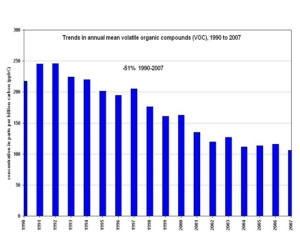
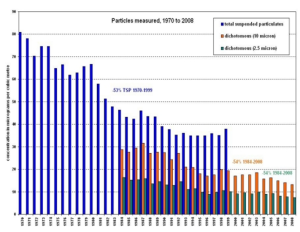
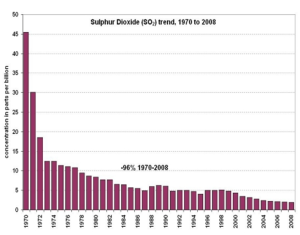
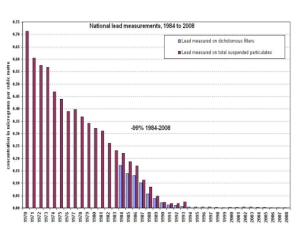
Transboundary air pollution across the Canada–United States border is also monitored in Saskatchewan. In keeping with the Saskatchewan Clean Air Act and the 1991 United States–Canada Air Quality Agreement, the Transboundary Monitoring Network was established to measure the flow of air pollutants across the Saskatchewan– North Dakota (Burke County) border. Environment Canada, Saskatchewan Environment, SaskPower, and the North Dakota Department of Health jointly operate a network of air-monitoring stations near the Boundary Dam and Shand power.
Air Pollution Mitigation
In most small Saskatchewan communities, the largest source of air pollution is fine particulates due to fire, agricultural activities, and road dust. While air pollution due to fire has been discussed in this lesson, road dust constitutes a significant portion of air pollution that can be mitigated.
Road dust not only consists of gravel fines, but also small amounts of other hazardous substances from tires and brakes of vehicles. As such, it poses a health threat in the same way any particulate matter pollution would. Additionally, not mitigating road dust can lead to increased road maintenance costs and environmental (including crop) damage.
There are two main ways of mitigating road dust: proper road engineering and chemical suppressants. Proper road engineering is preferred, however when it is not possible, and under certain environmental conditions, chemical dust suppressants are advisable.
Road engineering takes into account factors such as:
- The aggregate mix used to construct the road (ratio of fines to aggregate, and other additives such as clay). The goal is to maintain plasticity while achieving a proper level of cohesion and support from the course aggregate. Another factor is maintaining a proper road crown to ensure drainage.
- There is a linear relationship between vehicle speed and the amount of road dust. Where practical, reducing speed limits will reduce particulate matter pollution and road wear.
- It is generally advisable to pave the road for traffic vehicle volumes of 500 vehicles per day. While the initial cost is high, the reduced maintenance costs over time may be economical.
Chemical suppressants are sprayed directly onto the road or worked in slightly by blading. Probably the most common suppressants are chloride salts (such as sodium chloride, common table salt.) These salts work by absorbing water from the atmosphere. The water attracts the microscopic dust particles to keep them settled. This practice is generally environmentally safe but can affect the salinity of the adjacent ground and water. The salt also causes corrosion to vehicles.
Previously, used oil or other hydrocarbons were sprayed on roadways to prevent dust. This is no longer acceptable and banned by most jurisdictions. The used oil contains chemicals known to cause cancer, as well as heavy metals that accumulate in wildlife and are hazardous to health.
Journal Question:
Using the forum labelled “Course 9: Chapter 2” make a journal entry responding to the prompt below. Ensure that you title the entry “Lesson 2”. After writing a journal entry, go and make a comment on two other posts from your classmates. It can be about anything you noticed, liked, agreed with etc. The idea is to continue the dialogue about the topic.
Prompt: Think about the area where you live. Can you see or feel when the air is dirty? What do you think causes the most air pollution in your community? Now, imagine you have the power to make one big change to help reduce air pollution where you live. What would you choose to do and why? Write down your ideas, make connections to the lesson material and explain how your change could make a difference in making the air cleaner for everyone. Make connections to the lesson material
*View the journal entry and journal comment rubric to see how they will be marked
|
Criteria |
Exemplary |
Accomplished |
Developing |
Beginning |
|
Purpose |
Strong voice and tone that clearly addresses the purpose for writing. |
Appropriate voice and tone. The purpose is largely clear. |
Attempts to use personal voice and tone. Somewhat addresses the intended purpose. |
Demonstrates limited awareness of use of voice and tone. Limited evidence of intended purpose. |
|
Understanding |
Many interesting, specific facts and ideas are included. |
Many facts and ideas are included. |
Some facts and ideas are included. |
Few facts and ideas are included. |
|
Conventions |
All grammar and spelling is correct. |
Only one or two grammar and spelling errors. |
A few grammar and spelling errors. |
Many grammar and spelling errors. |
|
Reply |
Made two significant contributions to the online forum. Highly supportive of others. |
Made one contribution to the online forum. Supported group members. |
Attempted to contribute to online forum but was vague and unclear in the writing. |
Minimally involved. Offered limited support to online group members. |
Works Cited:
Government of Saskatchewan. (n.d.). Retrieved from https://publications.saskatchewan.ca/#/products/107311.
Stewart, I. (2006). Air Pollution. The Encyclopedia of Saskatchewan. Retrieved from https://esask.uregina.ca/entry/air_pollution.jsp.
Government of Canada. (n.d.). Coal phase-out. Retrieved from https://www.canada.ca/en/services/environment/weather/climatechange/canada-international-action/coal-phase-out.html.
Canada Energy Regulator. (n.d.). Provincial and territorial energy profiles – Saskatchewan. Retrieved from https://www.cer-rec.gc.ca/en/data-analysis/energy-markets/provincial-territorial-energy-profiles/provincial-territorial-energy-profiles-saskatchewan.html.
Saskatchewan Public Safety Agency. (n.d.). Community fire bans. Retrieved from https://www.saskpublicsafety.ca/communities/community-fire-bans.
Government of Canada. (n.d.). Electricity generation. Retrieved from https://www.canada.ca/en/environment-climate-change/services/managing-pollution/energy-production/electricity-generation.html.
MLTC Bioenergy Centre. (n.d.). Retrieved from https://mltcbioenergy.ca/.
Stewart, I. (2006). Air Pollution. The Encyclopedia of Saskatchewan. Retrieved from https://esask.uregina.ca/entry/air_pollution.jsp.
Environment and Climate Change Canada. (2022, April 28). National Air Pollution Surveillance Program. Retrieved from https://www.canada.ca/en/environment-climate-change/services/air-pollution/monitoring-networks-data/national-air-pollution-program.html.
Federation of Canadian Municipalities. (n.d.). Guide to dust control on unpaved roads. Retrieved May 30, 2023, from https://fcm.ca/sites/default/files/documents/resources/guide/infraguide-dust-control-unpaved-roads-mamp.pdf.
- https://www.cer-rec.gc.ca/en/data-analysis/energy-markets/provincial-territorial-energy-profiles/provincial-territorial-energy-profiles-saskatchewan.html#:~:text=About%2081%25%20of%20electricity%20in,power%20station%20is%20Boundary%20Dam. ↵
